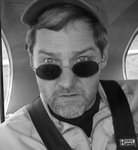Jake pressed his left thumb against the throttle’s microphone button and uttered the phrase that makes air traffic controllers smile, “Cancel IFR.”
“Husky 34V, cancellation received,” Center replied. “Squawk VFR.” And even though it wasn’t by the book, she tossed in a “G’day,” like blowing him an ATC kiss. Let the phraseology police write her a ticket; she liked being friendly.
“It is,” Jake said to a voice he’d never meet and changed the transponder code to 1200. He then switched frequencies to CTAF, but after thirty seconds of listening to that mindless clatter—“...traffic in the area, please advise…”— he turned off the radio, throttled back to low cruise and removed his headset. It was Friday afternoon and time to enjoy the commute, something earthbound creatures rarely do.
With controlled airspace behind him, the sky took on a more genteel tone. Suburban highways gave way to steep hillsides of redwood trees. As clouds clicked sunlight on-and-off, the landscape flashed between deep greens and mossy gray. He banked to glide down a shallow canyon where a logging road disappeared into the forest and easing in the throttle, pulled up again. It’s what classy tail draggers with lots of power do best.
As the Husky descended across the last ridge line, Jake slid the side window open and scooped his hand into the wind to inhale the sea air. Sunlight poked from beneath a thin marine layer, smearing his windshield so he had to look to the side to tell where he was going. But, after thirty years flying the Santa Cruz Mountains, Jake knew his position exactly.
He turned southeast bound along the shoreline where farm fields seemed to flow across the sea cliffs and into the surf. The coastal highway twisted like a lazy snake from Half Moon Bay and wriggled itself into the Santa Cruz city limits. Jake gazed across the water where specks of fishing boats floated as though placed there by a sloppy kid who refused to pick up his toys. He then looked inland at thousands of houses plastered up the hillsides and fed by streams of cars. And then, as he always did, he scanned from wing tip to wingtip and banked to watch the sunlight wash against the airplane’s yellow fabric. A hundred churches below couldn’t inspire the reverence he felt for this gift, and he thanked whatever made it possible and had blessed him with the view.
In the old days, as he liked to think of them, Jake might’ve been tempted by any of the beaches inviting a passing airplane to touch a wheel and skim where the surf rolled the sand flat. Often one to give into temptation, he’d have cut the throttle, pulled on full flaps and landed on a stretch of sand hidden among the cliffs. The Husky would make it easy. “Can land it down a chimney,” the seller had bragged, “and stop halfway across the fireplace.” His hand nudged the flap handle, but he’d avoid temptation, today, and continue to the airport.
Time was, Jake—then, a new pilot—thought nothing of landing his Aeronca Champ on an empty beach or along a farmer’s irrigation road in the Salinas Valley. But time, the law and, perhaps, some unexplainable mellowing that comes with experience—he refused to say, with age—caused him to fly a little higher and head home before the sun set. And this, being Friday, he had an appointment to keep at the hangar, one that had grown better with the years.
Ten miles out, Jake switched on the radio and suffered through the chatter of pilots who flew by their microphones and didn’t quite understand lift. Turning downwind, he spotted two Cessnas on final and a Cirrus on a base leg so wide he was tempted to cut inside and land ahead of it. Instead, he throttled back and slowed the Husky to near hovering speed to await his turn. When it came, he dropped on the base leg like a hawk on an unsuspecting mouse. With flaps full, and the runway numbers locked in the windshield, at 200 feet Jake glanced to make sure that Vern, the airport manager, wasn’t watching. And then, he sidestepped to the grass between the runway and taxiway. His wheels skimmed between two blue lights and touched in a gentle rumble. He was stopped and turned off before reaching the intersecting taxiway. But not before the airport manager saw him, and from his pick-up truck waved a shame-on-you index finger and grinned.
It’d been another routine commute across the mountains, and when the Husky stopped in front of the hangar, Jake checked his watch and saw that he was five minutes late. Already his hangar neighbor, Kathy, was seated in a lounge chair outside her hangar, an empty chair beside her and between them a small table, two glasses and, what Jake knew was a bottle of scotch.
He’d put the airplane away later, and walking quickly to join her, he apologized, “Sorry I’m late.”
“Headwinds?” she asked and didn’t expect an answer as she offered him a crystal glass, the lower third glowing limpid gold as though the setting sun had poured their drinks.
“Balvenie?” Impressed.
“Mmm,” she murmured. “Distracted along the beach, again?”
“Momentarily disoriented,” he answered and lifted his glass to touch hers. “You?” He nodded toward the Bellanca Super Viking inside her hangar.
“Had the same problem, only down south around Big Sur.
“Shame,” he said, and their glasses clinked. Then, in silence they watched the sun melt beneath the horizon, expecting it to hiss as it dropped in the Monterey Bay. Together, each in private reflection, they sipped the scotch and felt the warmth of near perfection flood the end of another flying day.
© Paul Berge
All other rights reserved by the author and Ahquabi House Publishing, LLC
